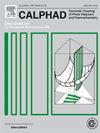Use of third generation data for the pure elements to model the thermodynamics of binary alloy systems: Part 3 – The theoretical prediction of the Al–Si–Zn system
IF 1.9
3区 材料科学
Q4 CHEMISTRY, PHYSICAL
Calphad-computer Coupling of Phase Diagrams and Thermochemistry
Pub Date : 2024-09-11
DOI:10.1016/j.calphad.2024.102742
引用次数: 0
Abstract
In a previous paper a method was developed to define Einstein temperatures for metastable phases of the elements and their relation to the so-called lattice stabilities used in the past, and also the variation of the Einstein temperature with composition to account for the composition dependence of the excess entropy. This approach was demonstrated successfully for the Al–Zn system. In this paper this approach is extended to cover the Al–Si and Si–Zn binary systems. The phase diagram for the Al–Si–Zn ternary system was then predicted from the thermodynamic description of the binary subsystems only without any ternary interaction parameters. Agreement with the experimental data is shown to be very good.
利用纯元素的第三代数据建立二元合金体系的热力学模型:第 3 部分 - 铝-硅-锌体系的理论预测
在之前的一篇论文中,我们开发了一种方法来定义元素逸散相的爱因斯坦温度及其与过去使用的所谓晶格稳定性的关系,以及爱因斯坦温度随成分的变化,以解释过剩熵的成分依赖性。这一方法已在 Al-Zn 系统中得到成功验证。本文将这一方法扩展到铝硅和硅锌二元体系。然后,仅根据二元子系统的热力学描述预测了铝-硅-锌三元体系的相图,而不需要任何三元相互作用参数。结果表明与实验数据非常吻合。
本文章由计算机程序翻译,如有差异,请以英文原文为准。
求助全文
约1分钟内获得全文
求助全文
来源期刊
CiteScore
4.00
自引率
16.70%
发文量
94
审稿时长
2.5 months
期刊介绍:
The design of industrial processes requires reliable thermodynamic data. CALPHAD (Computer Coupling of Phase Diagrams and Thermochemistry) aims to promote computational thermodynamics through development of models to represent thermodynamic properties for various phases which permit prediction of properties of multicomponent systems from those of binary and ternary subsystems, critical assessment of data and their incorporation into self-consistent databases, development of software to optimize and derive thermodynamic parameters and the development and use of databanks for calculations to improve understanding of various industrial and technological processes. This work is disseminated through the CALPHAD journal and its annual conference.

 求助内容:
求助内容: 应助结果提醒方式:
应助结果提醒方式:


